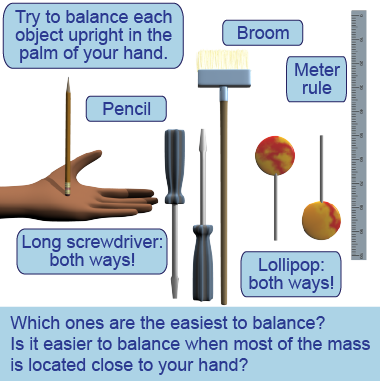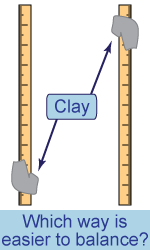| | Essential questions | | What physical effects result from rotational inertia? | |
|
Rotational inertia can affect the motion of objects that are not “rotating” in the sense of continually turning. A good example is “tipping over.” When an object tips over it is momentarily rotating about the point in contact with the ground. The rotational inertia about that axis determines how quickly the object tips! In this investigation, you will see how some objects are far easier to balance than others because they have different amounts of rotational inertia. For example, is it easier to balance a meter stick or a pencil upright on the palm of your hand? 
|
Part 1: Which has more rotational inertia?

- Hold a pencil upright in the palm of your hand and try to balance it.
- Repeat for a broom, a meter rule, a lollipop (with the sphere both at the top and the bottom), and a long-handled screwdriver (also both ways).
- Tabulate your results as to which ones are easy or difficult to balance.
- If gravity can rotate the object rapidly, such that you cannot keep the object balanced, then does the object have a little or a lot of rotational inertia?
- Which objects are easier to balance: those with most of the mass closest to or farthest from your hand?

|
Part 2: Rotational inertia of the meter rule with added mass

- Attach a large blob of clay near one end of the meter rule (around the 10 cm mark).
- By creating a model based on the physics of rotational inertia, predict when it will be easiest to balance the ruler: when the clay end is nearest to your hand or when the clay end is furthest from your hand.
- Try both cases and write down which one is easier.
- Which way made it easier to balance the meter rule?
- Does the meter rule have more rotational inertia when the clay is located close to your hand or far away? Why might this be the case?

|
| |
|

